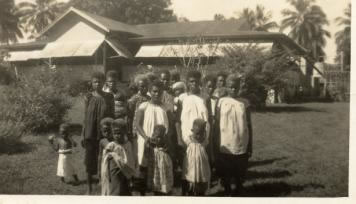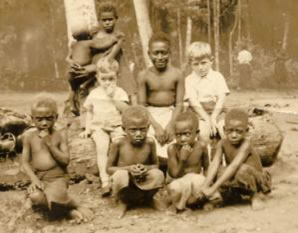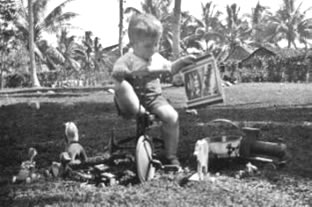
PNGAA Library
Memories from pre-war New Ireland: George Oakes

 I was born at Vunairima near Rabaul in 1934. My parents were Methodist missionaries at the time in the Duke of York Islands. When I was about 15 months old, my parents moved to Pinikidu Mission station in New Ireland where my Dad would be looking after the people of the central part of New Ireland, the Lelet Plateau (about 1,500 m in altitude) and the Tabar and Lihir Island groups.
I was born at Vunairima near Rabaul in 1934. My parents were Methodist missionaries at the time in the Duke of York Islands. When I was about 15 months old, my parents moved to Pinikidu Mission station in New Ireland where my Dad would be looking after the people of the central part of New Ireland, the Lelet Plateau (about 1,500 m in altitude) and the Tabar and Lihir Island groups.
Later in 1934, my mother heard that the Methodist missionary and his wife on the north coast of New Britain, near Cape Hoskins, had not had one baby but twin girls. My mother packed up some baby clothes including some baby dresses and sent them down to the Malalia Mission station for the twins, Edna and Nancy. (Twenty-four years later, I married Edna and now 53 years later again Edna still has a doll wearing one of those baby dresses!!)
The house at Pinikidu had four rooms down the middle which were mosquito proof, surrounded by verandahs. At the front of the house in the middle, the verandah was wider and partly enclosed and this was the lounge area. The kitchen was in a separate building at the back joined by a walkway to the house. The bathroom was on ground level near the tanks. At the back of the house there was a large mango tree and beyond this, the garage and a storage room. (After the war, the mission station was not re-established at Pinikidu but a little further down the coast at Kimadan.) In 1969, when I visited Pinikidu the concrete blocks that supported the house were all still in place but the house had been destroyed during the war. I considered the size of a house built on these blocks and thought it was much smaller than I remembered. Then it dawned on me that the last time I saw the house in 1941, I was only 7 and only a small boy and of course, the house would have looked much bigger. The concrete steps that were at the front entrance to the house were still there.
 The remains of our Chev. utility, which had been bought in 1939, were next to the house. The mango tree was huge. We visited the site again in 2002 and only the steps were there: the concrete house blocks had been taken away and supported teachers' houses for the Pinikidu Upper Primary School which had been constructed on the old mission station site. The mango tree had been cut down but the stump was still there, about 3 m in diameter.
The remains of our Chev. utility, which had been bought in 1939, were next to the house. The mango tree was huge. We visited the site again in 2002 and only the steps were there: the concrete house blocks had been taken away and supported teachers' houses for the Pinikidu Upper Primary School which had been constructed on the old mission station site. The mango tree had been cut down but the stump was still there, about 3 m in diameter.
I used to play under the mango tree with children from Pinikidu Village and had a swing from a branch of the mango tree. When I grew older, I climbed up the mango tree which had many branches and gave lots of shade. I remember on one occasion Mum got cross with me and I ran and hid under the house where she could not get me as the floor was only about 600 mm above the ground. On another occasion, Dad found a 5 m python in one of the boxes in the store room. He had the box carried out into the open then shot the python which was then taken away and eaten by our helpers.
I had several trips back to Sydney by ship with Mum, sometimes Dad and later my younger brother, Parker. Mum told me later that I had travelled on the Neptuna, Montoro, Malaita, Bulolo and Macdhui.
In 1937, we got a pinnace from the west coast of New Ireland near Namatanai to Rabaul. As we approached Rabaul, we went through lots of pummice floating on the water: the volcanoes had only erupted a few weeks earlier. I asked my mother if I could get out of the boat and run on the rocks next to the boat. I was firmly held on the boat after that.
A few times a year, we would go to Kavieng, about 180 km away, to do some shopping and meet other people at such places as the Kavieng Club. I always looked forward to these trips.
 At Pinikidu, we often had visits from plantation people who lived in the area. Mum was particularly friendly with the Chaddertons and got on very well with Mrs Chadderton. She had a daughter Denise who was a little over a year older than me. We used to play together a lot and I always would look up to her and do what she said. When we left New Ireland in 1941, our families went their different ways and I often wondered where Denise was. (Years later when our daughter was born in 1961, I convinced Edna to name our daughter – Denise! It was not until 2002 that I made contact with Denise again and found that she had retired with her husband to Ulladulla.)
At Pinikidu, we often had visits from plantation people who lived in the area. Mum was particularly friendly with the Chaddertons and got on very well with Mrs Chadderton. She had a daughter Denise who was a little over a year older than me. We used to play together a lot and I always would look up to her and do what she said. When we left New Ireland in 1941, our families went their different ways and I often wondered where Denise was. (Years later when our daughter was born in 1961, I convinced Edna to name our daughter – Denise! It was not until 2002 that I made contact with Denise again and found that she had retired with her husband to Ulladulla.)
In 1939, Dad constructed two concrete water tanks at each end of our house, one 4,000 gallon and one 5,000 gallon. This gave us a lot more water for household use. (In 1969, when I visited the house site again I found that the hand pump on one tank still worked. The other tank had had a hole cut into it during the war and I believe it was used as a shelter. When we visited the site again in 2002 the hand pump still worked on the tank.)
In 1939, we went on the Bulolo to Sydney. All of us children on board had breakfast first before the adults. One morning in Rabaul we were having breakfast when we heard two shots fired. There was a mass exodus by us kids from the dining room whether we had finished breakfast or not. We raced up on to the deck and saw that the Captain had shot a big shark which was not far from where some Tolais were swimming. The shark was then towed around the ship to the shore. None of us kids went back for breakfast.
When I was five, Mum started teaching me correspondence lessons from Blackfriars in Sydney. She always had a job getting me to settle down to lessons: I preferred to be outside playing. (I do not think she was very successful in teaching me as I had to start school almost from scratch in Sydney.)
I remember in about 1939, I got a lot of tropical ulcers on my legs and I had to rest a lot. Pinikidu had a lot of swamps nearby. (Even now I can see all the scars from these ulcers on my legs.)
Our cook at Pinikidu was Iotam who came from the Duke of York Islands. I always got on well with Iotam. (Years later, in 1964, when I was Patrol Officer at Kokopo, I met Iotam again on a patrol to the Duke of Yorks.)
In 1941, everyone became worried about the possibility of a war. Japanese ships had been seen around the islands. My mother was not well and it was decided because of the conditions, for her to go to Sydney and take my younger brother, Parker and me with her. Dad decided to stay until 1942 when he would have completed 10 years' service with the Methodist Mission and then resign and join us in Sydney. We left Kavieng on the Macdhui and waved goodbye to Dad. I never saw Dad again.
PS. I found that I could remember little of my early life at Pinikidu as I left at 7 years of age. Mum told me quite a bit and I learnt more from letters and papers and especially from my Baby Book in which my mother recorded everything carefully. However, I do remember that I had happy days at Pinikidu.